October 2010 - Stone Culverts for erosion control in South Wake County
Customers often have great ideas on how to add the natural beauty of stone to their homes while solving other structural and landscape design problems. This project began as one homeowner decided to put a stone culvert on either side of their driveway to prevent the ground from slumping further into the ditch at the front of the property. This property owner asked Behringer Stone to complete the project. The first step was to excavate enough of the dirt around the concrete drain to pour a concrete footing. Thin, textured stones were laid on top of the footing so that no mortar showed in the joints for a dry-stack look. A solid, pre-cut slab of dark grey slate was selected as a cap, and it was leveled off at the height of the driveway so that the soil would not fall into the ditch. When the neighbors next door and two doors down saw the end product, they approached Jeff Behringer for to do the same for their driveways. For each of these projects, the driveways also needed to be widened to prevent cars from sliding into the ditch during icy weather. Behringer Stone agreed to pour and finish the driveway extensions in addition to building the stone culverts. The end result was a distinguished-looking row of matching culverts and three happy customers.

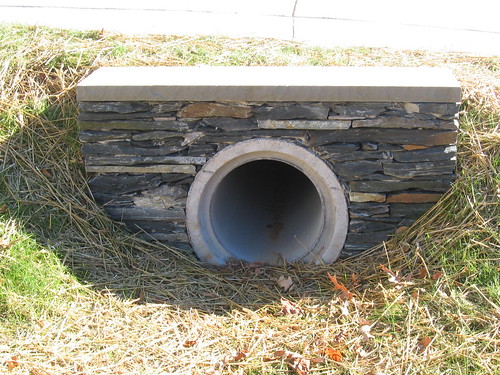
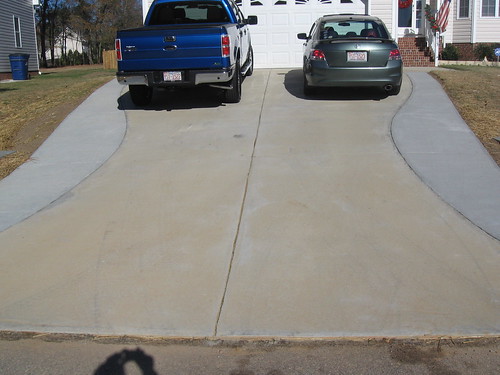
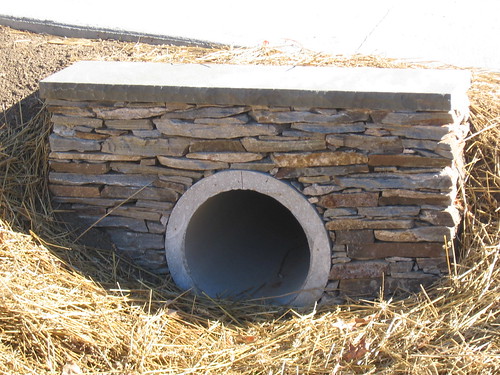
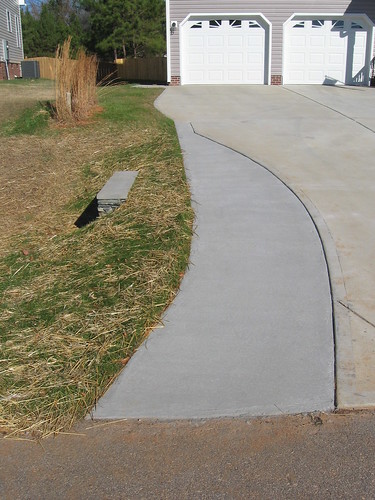

(Click images for expanded slide show)
September 2010 - Bagwell Vacation Home at Lake Gaston
The end of the summer in 2010 took Behringer Stone Company to Lake Gaston near the small town of Wise, North Carolina to work on a vacation home expansion project. The original stone used on the home's chimney was matched with a mixture of a few different kinds of stones in the retaining walls and steps that were added in the expansion. The pictures show retaining walls under a multiple-level patio and around the driveway. The step treads and surface of the patio was built using a flagstone that is fairly new to this area. It is called "Asian Blue Stone" and was originally quarried in China. Unlike the darker slate found in North Carolina or the sandstone varieties of Tenessee and Pennsylvania, this stone is a light bluish color that is a bit shiny. The photos also show that each piece has squared edges and were set in a pattern somewhat diagonal to the borders. While the square ends were cut by the distributor, fitting the stones into the desired pattern required additional daimond saw cutting so that the edges would fit tightly against the borders. The stones on the outer edges of the patio are also unique, in that all edges were rounded by the manufacturer using industrial routers. The end result of the choice of stone and Behringer Stone's professional craftsmanship is an elegant vacation home that fits in well with the natural beauty of Lake Gaston.
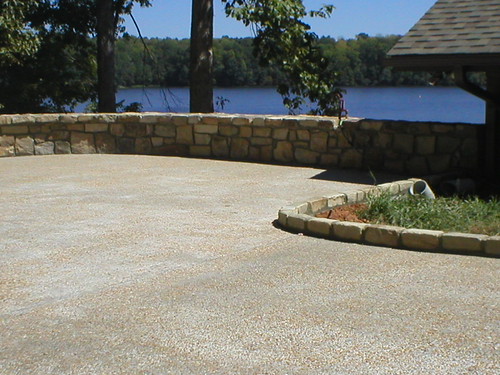


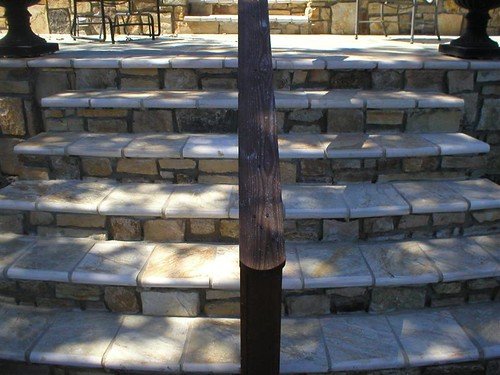

August 2010 - Flagstone sidewalk and steps near southwest Raleigh
At the end of July in 2010, after seeing the work of Jeff Behringer on the home next door, this homeowner hired Behringer Stone Company to complete an improvement project for the steps and sidewalk in front of the house. The stone selected for this was identical to some work done much earlier, and in addition to covering the existing concrete, the sidewalk was reshaped into a curvy, winding pattern that widened as it approached the front steps. At the special request of the customer, a sunburst-topped stepping stone was set into the widest section of the walk. A short retaining wall was then built downhill from the porch and steps, adding a nice accent to the landscape while helping to prevent erosion of its steep grade. Finished in the middle of August, this project required no small amount of sweat, but the end result is very appealing.





Spring 2010 - Stone columns, flagstone sidewalk and patio, and brick border near southwest Raleigh
The owner of this southwest Raleigh home is a landscape designer, who knew very well how to use stone to complement the natural surroundings of the property. Flagstone was used as a walkway leading to the front porch. Stone columns were placed along the walk and the front of the porch, which was bordered in brick by Jeff Behringer. In the back, a stone patio was constructed just outside the back door in the center of the house. Two stone columns were also placed on either side of the corner door, all of which accentuated the tree-covered yard.





early 2000s
High demand for new home constuction in the new century meant plenty of work for Behringer Stone Company. While fewer contemporary homes are made completely of stone, many are designed with natural stone around the foundation as an accent to some of the cost-saving and energy-efficient materials available today. The photos of this house in Durham, NC show a perfect example where stone was used to complement the aesthetic appeal and structural integrity of a modern home. Insulated synthetic siding is supported by the stone foundation, which helps to waterproof the crawlspace or basement and adds a more natural appearance to the house. Accents like these are almost essential in this tree-covered area.





Flagstone Driveway at Lonnie Poole Estate, Raleigh, NC
The Lonnie Poole home in Raleigh is yet another example where the homeowner came up with a unique stone design that turned out very nicely. The pictures below also show some of the work while it was in progress. Two columns on each side of the driveway were built with short walls coming off and tapering downward as they curved slightly away from the driveway. Another set of columns were placed in the middle of the forked driveway with a wall that dipped between the columns. Conduits for lighting were set in the middle of each column and in the middle of the central wall. Lamps were added to the tops of each column, and a two-lamp post was put in the center above an iron address plate. In addition, the blacktop at the ends of the driveway was cut into half-moon shapes with a diamond-blade circular saw so that flagstone could be inlaid into the pavement. A large circle was then cut into the blacktop further up the driveway, and flagstone was laid into it. Finally, a stone curb was set alongside the driveway toward the house.








1980s and 1990s
Stone Columns at Chavis Heights in downtown Raleigh, NC
The city of Raleigh, North Carolina began a downtown revitalization project in the 1990s. Before that, neighborhoods near the city center had become dilapidated, and very few of the streets were pleasant and inviting. Part of the city's efforts to change downtown was to beautify the areas around downtown so that people would consider buying houses, investing in downtown businesses, and spending time in the area. One initiative was to build stone markers on streets that needed improvement, and Behringer Stone Company was hired to do this on Chavis Street in downtown Raleigh. The style of stone masonry used on many historic stone homes in Raleigh was also used on these columns. The stones originally came from a now abandoned Wake County quarry, and the mortar joints were raised using a special beading trowel. These columns match many of the other improvements in the neighborhood and are a fine example of Jeff Behringer's skills in traditional stone masonry and restoration work.



Stone Mansion on Bill Britt Estate in Chapel Hill, NC
This Chapel Hill mansion is the largest project undertaken by Behringer Stone Company to date. The house was built on land adjacent to the homeowner's original abode, and the stone used on the new building was obtained by on-site excavation. This stone is native to Chapel Hill and can also be seen around the local university campus. Mr. Britt had the indigenous stones excavated, and Jeff Behringer used it to construct chimneys, columns, walls, and curbing seen in the pictures below. Thin flagstone was purchased to construct the walkways and steps surrounding the house. The last phase of the project was the entrance gate. In one of the photographs below is the sand-blasted name of the owner set in stone in the center of a gate.













1970s - Knightdale, NC
The earliest substantial project undertaken by Jeff Behringer's stone company, after its founding in 1973, was in the east Wake County town of Knightdale. The job was on a private lakefront residence and was completed using traditional thick-wall stone masonry. The photos below show the process of traditional stone construction, which starts with a concrete foundation thick enough to stabilize the walls and roof. In most old stone homes, concrete blocks are laid so that the stone walls would have structural support and a material to which mortar would bond. Finally, stones are fitted together with mortar for the finished product, a beautiful and very durable stone house.




